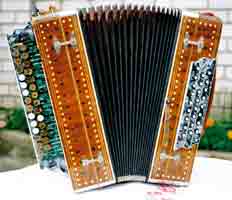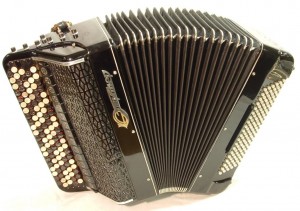The Bayan Russian Accordion – A Sound With History
Written by Vadim on April 13, 2011 – 6:01 pm -
If you have ever listened to Russian folk music, you have heard the distinctive sound of the bayan. Comparable to the accordion that Westerners are so familiar with, this musical instrument provides a similar sound with unique Eastern European flair.
The bayan may look like an accordion in many ways, but there are key differences as well. Most notably, this instrument uses buttons rather than the piano keys seen on Western accordions. The bayan also has much less tremolo, but instead a clear, unwavering note. The reeds are attached to the plates in large groups rather than in pairs, and they are attached with screws rather than wax. These reeds are a different shape as well, giving a slightly different sound. The bass in particular has a unique tone that is usually described as sounding deeper and fuller than that of the classical accordion.
These and the many other small features that set the bayan apart have given the musical instrument an irreplaceable place in Russian folk music. They have a much wider range than the average accordion, and thus can be used for a more diverse range of music. Music lovers describe the bayan as having a different ‘tone color’ than other accordions, but you don’t have to be a music snob to appreciate the depth and Old World charm of this instrument.
In addition to being widely used in Russian and Ukrainian folk music, the bayan is used in classical arrangements as well. Several notable Russian composers have written classical compositions using the bayan, and many well-known classical songs can be easily performed on the instrument with beautiful effect. In fact, under the Soviet government, the bayan was treated with special privilege as a historically Russian instrument, with training and lessons available for free at public elementary and music schools. Eastern Europeans tend to see no distinction between ‘folk art’ and ‘classical art’ as other cultures might, so the bayan remains an esteemed and well-recognized instrument throughout Russia and the countries she has influenced.
Indeed, the bayan has a distinctively Russian heritage that almost no other folk instrument can claim. This musical instrument was first created in eighteenth century St. Petersburg, a center of Russian arts at the time. The bayan caught on in popularity, and mass production began in the early nineteenth century. By the late nineteenth century, the bayan looked almost identical to its modern form. The first musical conservatory program of studies dedicated to the bayan was developed in Kiev in 1927, and the first concerti for the instrument were written ten years later by Rubtsov and Sotnikov.

The bayan is an essential part of many Russian folk songs, especially those performed for the well-known Cossack dances. As a result, bayan music has spread throughout the world to the many far-flung communities that boast a strong Russian heritage. In fact, some of the world’s most famous and accomplished bayanists, such as Victor Danilochkin and Gennady Gutkin, are from New York City.
As Russian folk music spreads over the globe, the bayan is gaining enthusiasts from a variety of locales and cultures. In fact, you just may hear this distinctive tone at a folk festival or other celebration near you!
Tags: accordion, bayan, russian accordion
Posted in General | No Comments »




You must be logged in to post a comment.